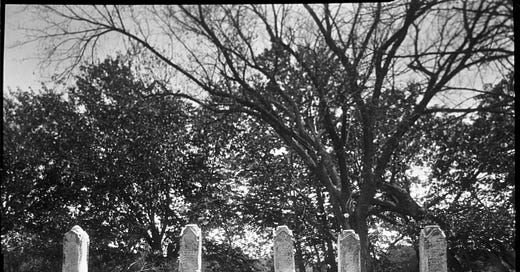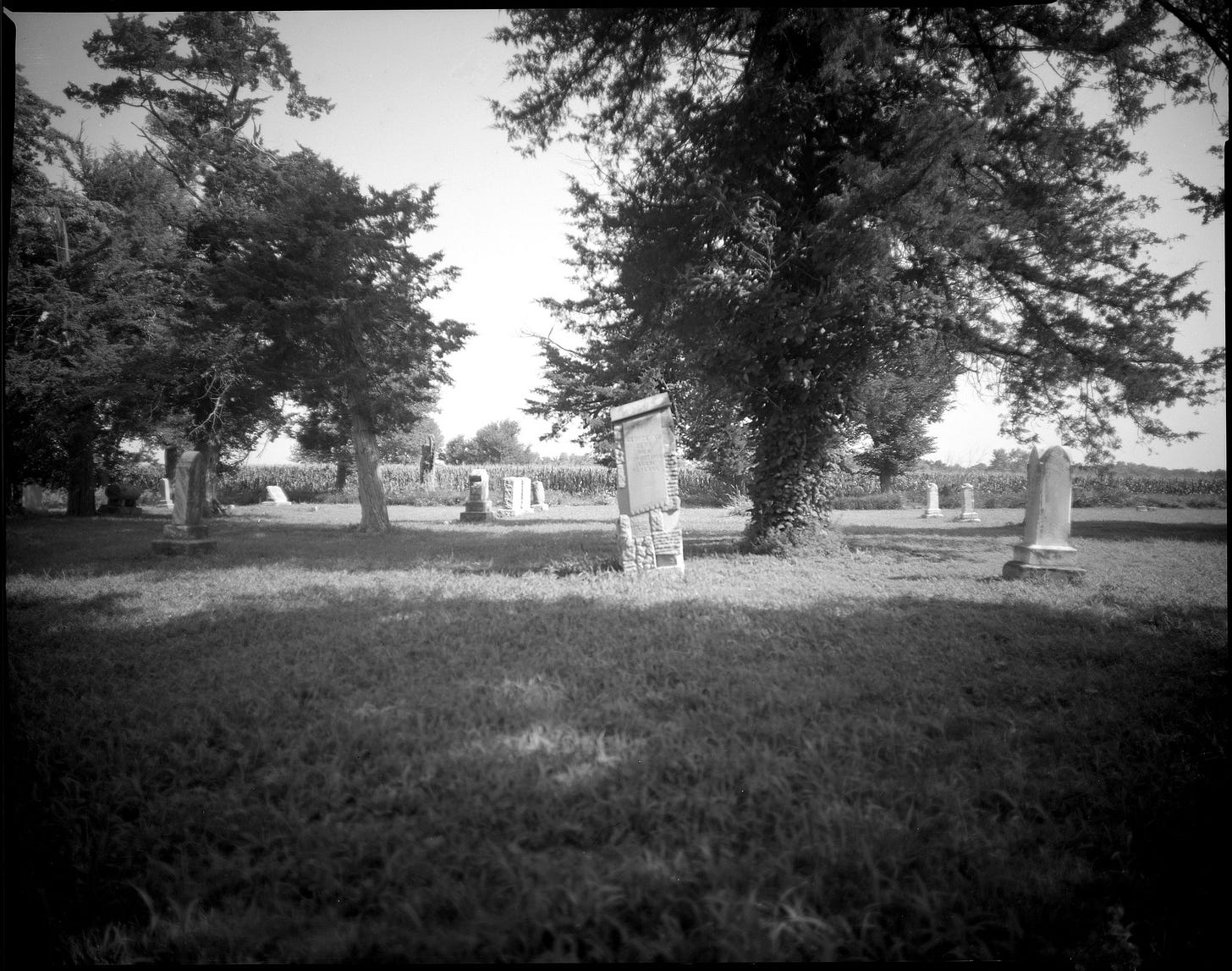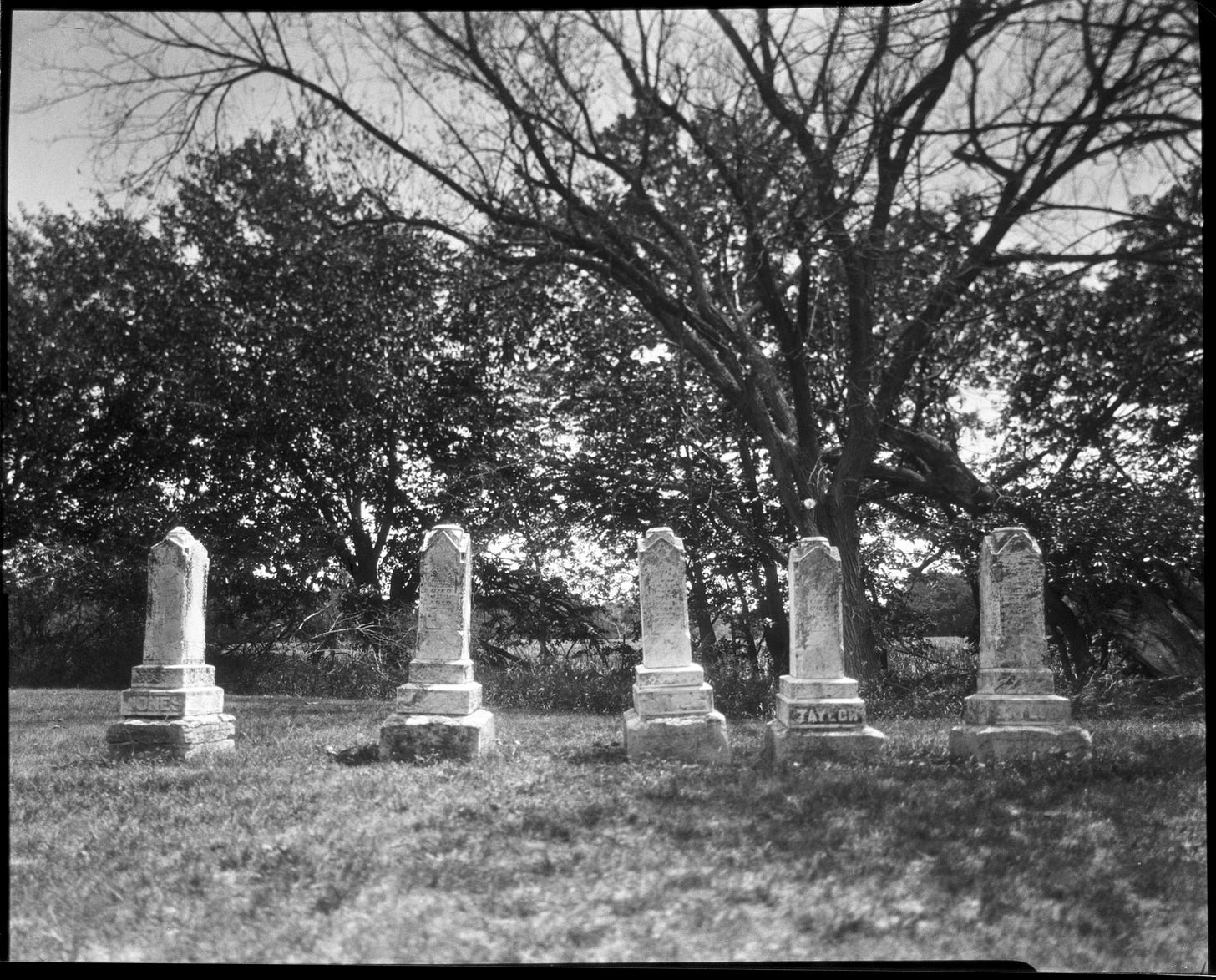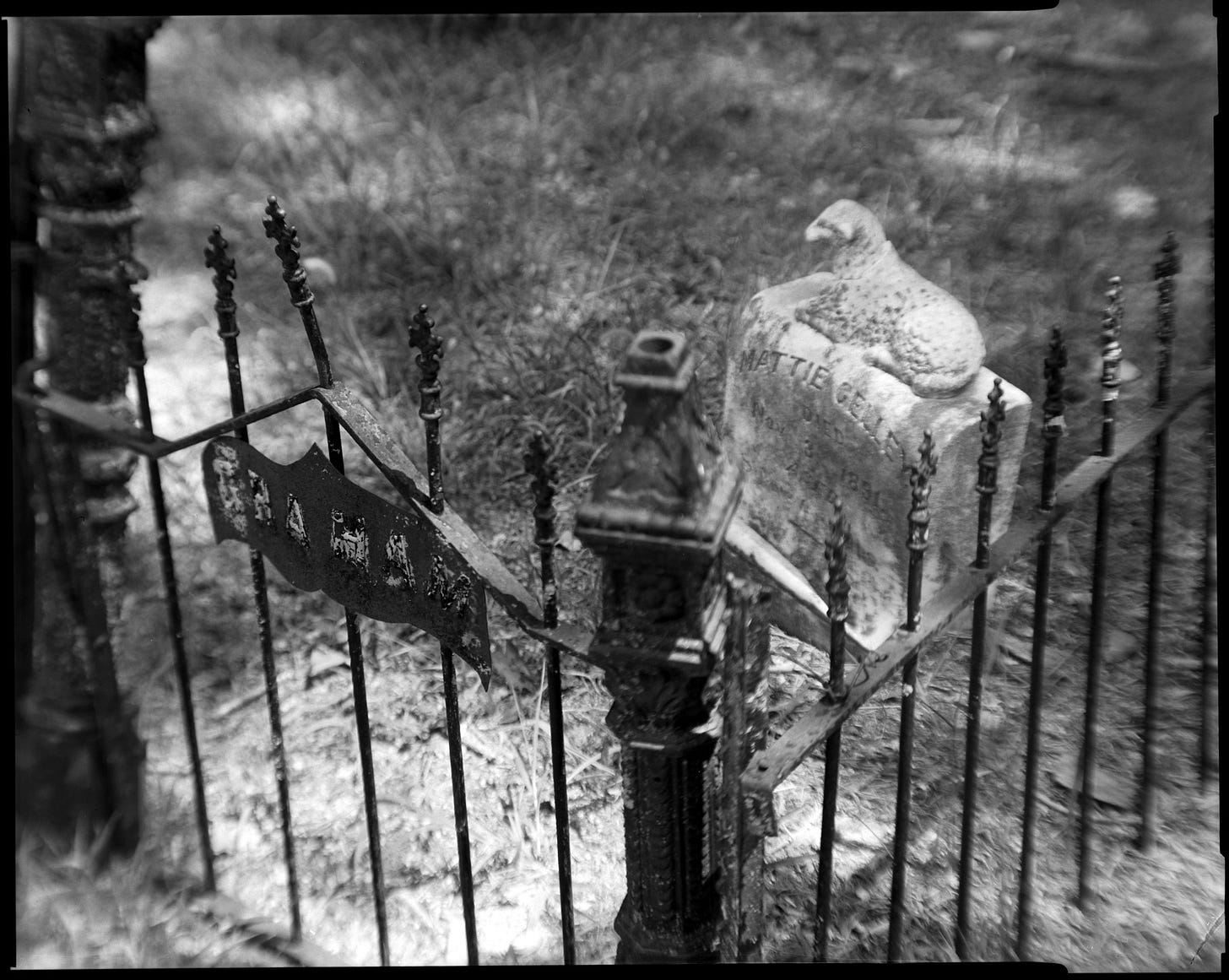Spring Ranch is "known" as the most haunted ghost town in Nebraska, though I'm not sure by which metric it achieved that knowing.
Spring Ranch Cemetery looks like any normal cemetery. There's a gateway, a lane down the middle and your typical array of stones on either side.
While I was there photographing, I felt no hauntings, no specters, spooks or haints. There are no ghosts in the ghost town of Spring Ranch, and the cemetery is filled with the town's history, parceled out for those who can read it in marble and granite.
I walked softly in Spring Ranch Cemetery. There is a hard history here that you can almost feel. It’s not so different from other pioneer cemeteries. It was hard everywhere in the late 1800s. The life they chose was backbreaking and mentally torturous.
This can be seen hiding under the soft veneer of county histories and family recollections. Spring Ranch probably wasn’t much harder than any of the thousands of other frontier towns. But I quickly uncovered two stories that describe and define just how Spring Ranch, and the frontier in general, could break you.
Though it contains somewhere around 100 stones, this is one of the larger cemeteries I’ve photographed. My preference lies in the small, abandoned cemeteries dotting the west. But Spring Ranch is almost sprawling in comparison. The main cemetery drive still exists down the center, but on the sides and in the corners are small gatherings of stones here and there.
Most are family plots, separated and set aside for no other reason than the cemetery never got the chance to fill itself out. One such assemblage caught me.
There was a row of five stones, neatly placed. On the left, the two farthest apart belong to Margaret and John Jones, husband and wife. John died first in 1882, not living long enough to bear witness to what came after. His wife, Margaret, lived to see it all, dying in 1894.
To the right are three additional stones, somewhat clustered together. Margaret and John had two children, Elizabeth and Thomas, born in 1848 and 1851, respectively.
The Jones Family came to America from Wales, arriving probably in the 1860s. They, like the others, came west across the Plains and settled in Spring Ranch. By the time they settled, Elizabeth and Thomas were likely near to adulthood.
The third stone, curiously lying between the children and their parents, is to James Taylor, Elizabeth’s husband, whom she married in 1869 at the age of 21. James was from Missouri and was two years younger than Elizabeth.
The preamble to this story is hard to piece together. It was only written about after the occurrence on the bridhauntingsge, when opinions had already been formed and transformed by these events.
Somehow or another, at the age of 33, Elizabeth’s husband, James, died. It was 1882, but over the years, his untimely death morphed into an “unexplained” death, and then to a “suspicious” death. Finally, it was assumed that Elizabeth poisoned him with potato bug poison. However it happened, James was dead.
Over the course of the next two years, the town turned upon Elizabeth and her brother Thomas, who the papers described as an “unmarried man, whose mother kept house for him.” They were suspected as leaders of a larger gang of cattle thieves and general no-goods.
Things came to a head when Edwin Roberts was murdered in January of 1885. According to the Nebraska Signal:
Last week, Edwin Roberts, tenant on the farm of Mrs. Taylor in the southwest precinct of Clay County, went down to the Blue [Little Blue River] to cut some bushes, and while at work, Mrs. Taylor, two sons aged twelve and fifteen, and a hired youth not much older by the name of Brewer, drove up near where Roberts was at work.
They had with them a loaded shot gun. The younger boy held the team while the others got out and walked up to within a few steps of Roberts and at once shot and killed him.
The Taylor Family is said to be very depraved. The parties have been arrested and although the people are much excited over the murder, will probably await the action of the court.
The people of Spring Ranch were indeed much excited, but they were not about to await the action of the court. While the governor of Nebraska issued a warrant for the arrest of David Brewer, the locals believed they knew better what happened to Edwin Roberts.
Elizabeth’s two sons might have pulled the trigger, but it was Elizabeth and maybe her brother Thomas who were responsible. While Thomas was liked well enough, or at least tolerated, according to the local papers, Elizabeth “had never had a good reputation in the neighborhood.”
The same paper went on to describe her as: “not a tall woman, but rather short and stout and has rather a coarse expression about her face that is seldom seen in a woman.”
The family, especially after the untimely and/or suspicious death of her husband, James, grew to include what the locals considered a gang.
Of this gang, the Lincoln Daily Nebraska State Journal reported:
It seems as though there was an organized gang of hard characters in the Jones and Taylor families and there have been more or less strangers stopping among them who would not stop at anything short of murder, if even at that, and it seems as though it was the intention of the community to get rid of the whole pack and parcel of them.
Of late there has been a number of fires in the neighborhood, stock has been killed and various other atrocities have been perpetrated. Such things cannot last always and when the gang is routed out, then they will cease and people can live in peace.
But there was to be no peace. Again, according to local reports on Elizabeth:
After the murder of Roberts and the imprisonment of her two sons, she would always remain overnight at the home of her brother, going back and forth to her own home which is about a mile distant, only during the day. She was always afraid to stay at her own home alone although she was always armed or had arms handy.
The home of her brother, Thomas, was a sod house with walls four-feet thick. It was only one story and sat maybe ten feet high. Its front held two small windows and a door. The roof was sod and heavy, requiring four sturdy pillars running through the center of the house to hold it up. The inside was set up more like a stable than a house, with low walls dividing the sleeping quarters from the living spaces.
The events that transpired on the night of March 15, 1885, two months after the murder of Roberts, are confused, lied about, and likely forgotten. Reading from contemporary newspapers can only retell so much, but it is all that remains.
According to the Hastings Gazette Journal:
The mob appeared at the house of Tom Jones wherein were seven persons, Mrs. Jones [Margaret, the mother], Mrs. Taylor [Elizabeth] and her daughter, Maggie, a bright looking girl of five years of age, Nelson Celley, John Foster, Texas Bill [an alias], and an older person by the name of Clark, and a boy whose name no-one knew. As soon as the mob reached the house, they demanded that Mrs. Taylor [Elizabeth] and Tom Jones should come out, but instead of complying with the request, the door of the house was barricaded and other means taken to prevent a forcible entrance.
Those inside were well provided with firearms and just why they were not used by them is a mystery as they had just been purchased for such an occasion. After parlaying for some time, the men in the mob were determined to have them out and threatened to throw a bomb of dynamite in the window.
At this juncture, Tom Jones asked Texas Bill if he thought it would be safe to go out and was answered that it would. Thereupon Tom Jones said that he would come out and was told by the mob to crawl out of the window, as he would not be allowed to go out of the door and he was also told to leave all firearms behind him and crawl out with his hands up. This he did and upon his appearance was immediately covered with revolvers and guns and was taken to one side and his hands tied with a piece of rope which was procured from some mule harness belonging to Mrs. Taylor.
Mrs. Taylor was then ordered to come out and she too came out of the window the same way and had her hands tied also. The men then took them into a little open spot near the house and leaving them under a guard drew off a little ways and held a consultation which ended in Mrs. Taylor and Tom Jones being taken one direction and the other four men who were in the house were taken in another.
There was one thing noticeable in the transaction, that while three of the men’s hands were tied, Clark, Celley and a person whose name was not known as he had only been there one or two days, Texas Bill was allowed to go free and he made himself scarce. It is supposed by some that he was in with the mob.
Be that as it is, the other three were taken to the house of a Mr. Reese and locked up where they remained until late Sunday morning. The men who had Mrs. Taylor and Tom Jones in charge, told them what they intended doing. The couple then began pleading for mercy, but the men were obdurate. They were given time to pray shortly after having been taken from the house and again when they arrived at the bridge.
They both improved the brief opportunity allowed them to pray and when they arrived at the bridge, the ropes which were taken from some halters were adjusted around their necks and they were shoved off into eternity.
[Another paper reported: “Tom Jones’ neck was broken, but his sister, Mrs. Taylor, died the terrible death of strangulation.”]
The men then went back to the house where they had left Mrs. Jones and Mrs.Taylor’s daughter and begged her pardon for intruding and then took their departure.
The bodies remained hanging where they had been hung till Sunday afternoon about 3 o’clock. They were discovered about 8 o’clock in the morning by a woman who was crossing the bridge. Several persons were notified and one of them went to notify the coroner of Clay county, J. S. Liler, who arrived in the afternoon about 3 o’clock and cut the bodies down. A jury was impaneled and an inquest held. It was held secretly and the persons who testified to the jury could not or would not throw much light on the matter.
The bodies were placed in neat coffins and lay in the house where they were first taken until yesterday afternoon when they were taken to the Spring Ranch cemetery and buried both in one grave.
Before the burial, reporters circled and descended upon Spring Ranch, collecting what information they could. They found Margaret Jones, the mother of the two who were lynched, in Tom’s sod house. The reporter explained the layout of the house before adding:
“At least that was all our reporter could see. If there was any other, it was hidden by the stygian darkness that reigned with the exception of just where the windows were.
On the bed near the stove sat the mother of Tom Jones and Mrs. Taylor. On being asked a number of questions by our inquisitive reporter in regard to the affair, she answered in a tone and manner which with the rude surroundings made the cold chills chase each other up and down his back. After gleaning all that could be obtained from her, our reporter got out of the house into the free air, glad that the ordeal was over.”
The reporter then went to the bridge to find a piece of the rope to keep as a souvenir, but found nothing.
A day or so after the lynching, the nearby town of Sutton “censured” the vigilantes, but for the most part, nobody was speaking. Over the course of the next few weeks, five of those thought responsible were rounded up and brought to Clay Center, the county seat. These were “well-to-do men and influential citizens,” according to a local paper. This attracted a large crowd of around 500 angry people who sided with the accused.
During the lead up to the trial, several of the leaders were identified by witnesses. But the crowd at the courthouse grew wild over the idea that the vigilantes might be convicted.
“Such a pressure was brought that Judge Burnett discharged all the prisoners,” read the Lincoln, Nebraska paper. “The mob then whooped and yelled and made threats against certain Hastings men, when John Ragan, their attorney, mounted the table and urged them to be quiet and keep the peace. After the examination, many guns and revolvers were seen, and this ended the effort to prosecute the supposed lynchers.”
Perhaps in an attempt to lay this whole thing to rest, a year later, Elizabeth’s two sons, William and John, who had been accused of murdering Edwin Roberts, were acquitted of all charges.
But it was not quite over for everyone involved. Three years later, according to the Omaha Daily Bee in February of 1888, “a small man with reddish grey whiskers, dressed in brown clothes with cap drawn down over his face” was found hanging to a nearby railroad bridge. This unnamed man was “a prominent farmer who had resided in this locality for years and the general conjecture is that it was a suicide caused from remorse.” He was one of the mob who lynched Elizabeth and Thomas, and had “become mentally unbalanced from remorse.”
I knew none of this when I took the photo, of course. All I knew was that here was a line of gravestones. It was probably a family. Three of them died in their early 30s. Two of them on the same day. There was a story here, I thought. And there was also a photo.
There was no unsettling feeling, no premonition of a story to be told. But I hoped something might come along.
My eyes then turned to a broken stone not far off. The base was still planted in the ground, with most of the stone leaned against it. “Farewell” it read above an engraving of two hands clasped.
“Susan, wife of Robert Cargill” it continued. “Died June 29, 1883; aged 42 years.”
I framed the stone with some foreground to give it space, moving the stone itself to the left of the frame. A small patch of weeds covered her death date. I made sure to not lose the “Farewell” to the background.
Susan died two years before the lynching of Elizabeth Taylor and Thomas Jones, but her absence might have sent their own ripples through her family and through the community of Spring Ranch.
Susan and her husband Robert had ten children together, all of whom were still alive when she passed on at the young age of 43. Following her death, Robert and the family moved north to Merrick County. Two of their ten children, Lewis, born in 1869, and Margaret, born in 1877, became close.
Margaret married Absolom Baird, originally from Iowa, and by 1902 had two children, a boy and a girl.
The Howard County Herald told the most complete story. By “complete,” I do mean that, and I warn you that it does not shy away from the details. But this was how journalism was done in the early 1900s. And this is how I’ll present it:
Dead By Her Own Hand
Gage Valley Woman Suicides Without Apparent Cause
Margaret Baird, wife of A.D. Baird of Gage Valley precinct, committed suicide yesterday afternoon by shooting herself through the head with a 22-calibre rifle. The deed was done during the absence of her family and was evidently the result of deliberately laid plans. The news of the affair was brought to town late in the evening and Coroner Grothan went out immediately to hold an inquest.
A jury [...] was empanelled and, at the solemn hour of midnight, with the body of the unfortunate woman still lying on the floor covered with her own blood, a verdict was found that she came to her death by a self-inflicted gunshot wound.
Mr. Baird was in St. Paul [Nebraska] until late last evening. At about 4 o’clock in the afternoon Mrs. Baird sent her two children to a neighbor’s with instructions not to return for an hour and a half. After they had gone she prepared to take her own life with the utmost deliberation. She wrote a note which she left lying in a conspicuous place. It read as follows:
“I don’t want to blame Abb for this because I did it myself. I make everyone miserable. I love Abb as dear as I could anyone. Goodbye. From Mag to Abb. Abb, I love you. I am so shaky.”
She then loaded the rifle, seated herself on a chest, placed the muzzle against her right temple and pulled the trigger. She had previously prepared herself for the coffin by dressing herself in black.
No motive for the rash deed is known. Mrs. Baird was a woman of between 23 and 25 years and had always enjoyed fairly good health. She was a daughter of Robert Cargill, a well known Gage Valley farmer. Besides her husband she leaves two children – a boy and a girl – the oldest being only about 6 years of age.
She also left Lewis, her brother. He took the news hardest of all. He was unmarried and lived alone near to the Bairds. A month later in May 1902, the St. Paul, Nebraska Phonograph ran a story with the garish headline: “Louis Cargilll Insane.” His name was misspelled, but it continued:
Since the death of his sister, Mrs. A.D. Baird, by suicide, Louis Cargill has been subject to severe attacks of melancholy and about a week ago his father, Robert Cargill, took him home. It seems that nothing could be done to remove the effect of the sad termination of his sister’s life.
This so preyed upon his mind that a physician was called and after careful examination it was thought best to bring the matter before the board of insanity.
Acting on this, a session of the board was held last Monday and after hearing all the evidence, it was thought best to take the patient to Lincoln.
This is indeed a sad case and it is to be hoped that Mr. Cargill will soon be restored to health.”
Another paper, the Lincoln Daily Post, clarified, explaining that Louis [sic] Cargill “has become violently insane and will have to be placed in an asylum.”
Just over two weeks later, the Howard County Herald ran a very short story, not even bothering with a headline:
Louis Cargill, the Gage Valley farmer who was taken to the insane asylum at Lincoln about a month ago, died the early part of last week. His health has failed rapidly as a result of his mental affliction and death came quickly to his relief.
Less than two months after the death of his wife, and two weeks following the death of Louis, Absolom Baird moved away. This too was covered in the St. Paul Phonograph:
A.D. Baird and children, Lonella and Jessy, left Friday morning for Redding, Iowa. He has rented his farm and goes to accept a position with his brother at the carpenter trade.
He intended to leave Monday morning, but was detained on account of the sickness and death of Lewis Cargill. We are sorry to see him leave, as we always considered him one of our best neighbors, always ready to give a helping hand. We sincerely hope he will decide to return to his farm, and wish him success in his new undertaking.
Four years later, the A.D. Baird farm was sold to the highest bidder. He would not be returning.
As I snapped this final picture of Susan Cargill’s grave in Spring Ranch Cemetery, I knew none of this. There wasn’t even a hint of a story. There was only warm sunshine and this broken stone. I used a very dark neutral density filter and a brass lens without a shutter. I help open the exposure for four seconds, counting softly to myself.
Spring Ranch is "known" as the most haunted ghost town in Nebraska, though I'm not sure by which metric it achieved that knowing.
While I was there with my camera, I felt no hauntings, no specters, spooks or haints. There are no ghosts in the ghost town of Spring Ranch, and the cemetery is filled with the town's history, parceled out for those who can read it in marble and granite, and for those who are willing to dig a little deeper.
















Share this post